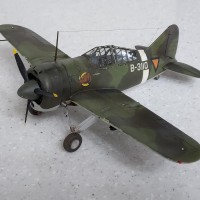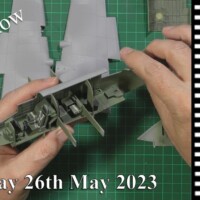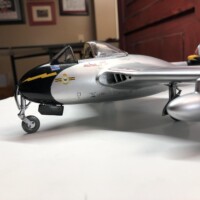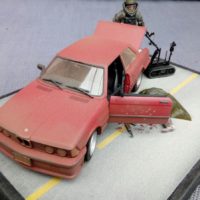SE.5A (Hispano Suiza), 1:48, Eduard, Lt. William Gordon Claxton, 41 Squadron, 37 victories
The Royal Aircraft Factory SE5a is a British World War I biplane fighter aircraft. It was developed at the Royal Aircraft Factory by a team consisting of Henry Folland, John Kenworthy and Major Frank Goodden. It was one of the fastest aircraft of the war, while being stable and relatively maneuverable. According to aviation author Robert Jackson, the SE5 was: "a nimble fighter that has since been described as the 'Spitfire of the First World War'".
In most respects the SE5 performed better than the competing Sopwith Camel, although it was less immediately responsive to the controls. Problems with the Hispano-Suiza engine, particularly with early versions powered by the HS 8B gearbox, meant that there was a chronic shortage of the type until 1918. Thus, while the first examples arrived on the Western Front ahead of the Camel, there were fewer squadrons equipped with the SE5 than the Sopwith fighter.
Together with the Camel, SE5 was instrumental in regaining Allied air superiority in mid-1917 and maintaining it for the remainder of the war, ensuring that there would be no repeat of "Bloody April" 1917, when losses in the Royal Flying Corps were far greater than in the Luftstreitkräfte. The SE5s remained in RAF service for some time after the Armistice that ended the conflict; some were transferred to various overseas military operators, while a number were also adopted by civilian operators.
The SE5 (S cout E experimental 5) was designed by Henry Folland, John Kenworthy and Major Frank Goodden at the Royal Aircraft Factory at Farnborough. It was powered by the new 150 hp (112 kW) Hispano-Suiza 8, a V8 engine, which, while providing excellent performance, was initially underdeveloped and unreliable. The first of three prototypes flew on 22 November 1916. The first two prototypes were lost in crashes (the first killing the chief test pilot at the Royal Aircraft Factory, Major Frank Goodden, on 28 January 1917) due to a weakness in the wing structure. The third prototype underwent modifications before production began; The SE5 was known in service as an exceptionally powerful aircraft that could dive at very high speeds - the angular wings also provided much better lateral control at low speeds.
Like the Royal Aircraft Factory's other major warplanes (BE2, FE2 and RE8), the SE5 was inherently stable, making it an excellent gunnery platform, but it was also quite manoeuvrable. It was one of the fastest aircraft of the war at 138 mph (222 km/h), a speed at least comparable to the SPAD S.XIII and faster than any standard German type of the time. While the SE5 was not as nimble and effective in close combat as the Camel, it was much easier and safer to fly, especially for novice pilots. According to "Dodge" Bailey, former chief test pilot of the Shuttleworth Collection, it had "somewhat similar handling characteristics to the de Havilland Tiger Moth, but with a better surplus of power".
William Gordon Claxton DSO, DFC & Bar (1 June 1899 – 28 September 1967) was a Canadian World War I flying ace who claimed 37 victories. He became the leading ace of his squadron.
Claxton was born on 1 June 1899 in Gladstone, Manitoba, and on his eighteenth birthday in 1917 he enlisted in the Royal Flying Corps (RFC) in Canada. After pilot training at Camp Borden, he was assigned to No. 41 Squadron in France the following March flying SE5a aircraft. Claxton arrived on the Western Front late in the war, but had a string of victories that saw him emerge from the war as his squadron's most successful aviator. During the last year of the war, he claimed 37 aerial victories in 79 days. This meteoric career was marked by several multiple winning days. His composure under fire earned him the nickname "Dozy". This also put him in situations where his planes suffered battle damage. In June 1918 alone, he made an emergency landing once and brought home shot down planes twice.
On August 17, 1918, Claxton was shot down by Leutnant Johannes Gildemeister during an encounter with Jasta 20 in which he and co-pilot Frederick McCall were outnumbered 20-to-1; by this time he had amassed 37 aerial successes. In this engagement he shot down three enemy aircraft before being hit. Claxton crash-landed behind enemy lines with a serious head injury and was saved only by a quick visit to a German doctor who performed a skull operation.
Claxton's final score was two observation balloons destroyed, 16 aircraft shot out of control, and 19 aircraft destroyed. The two aircraft he destroyed shared the victory with No. 41 Squadron's second ace, Frederick McCall.










Excellent result on this SE5, Milan @milantesar
Thanks for sharing the historical part of this aircraft.
Thank you John.
Very nice work on this @milantesar.
Thank you Tom.
A solid build - well done!
Thank you Greg.
Well done, Milan!
Thank you John.
Lovely SE.5A! Interesting to read that the SE.5A had handling characteristics similar to a Tiger Moth. Kind of makes the Tiger Moth movie stand ins for SE,5As a little more palatable.
Thank you Robert.
Excellent result and a very informative article, Milan!
Thank you Spiros.
A great looking SE5 Milan, one of my favourite biplanes.
Thank you Ian.